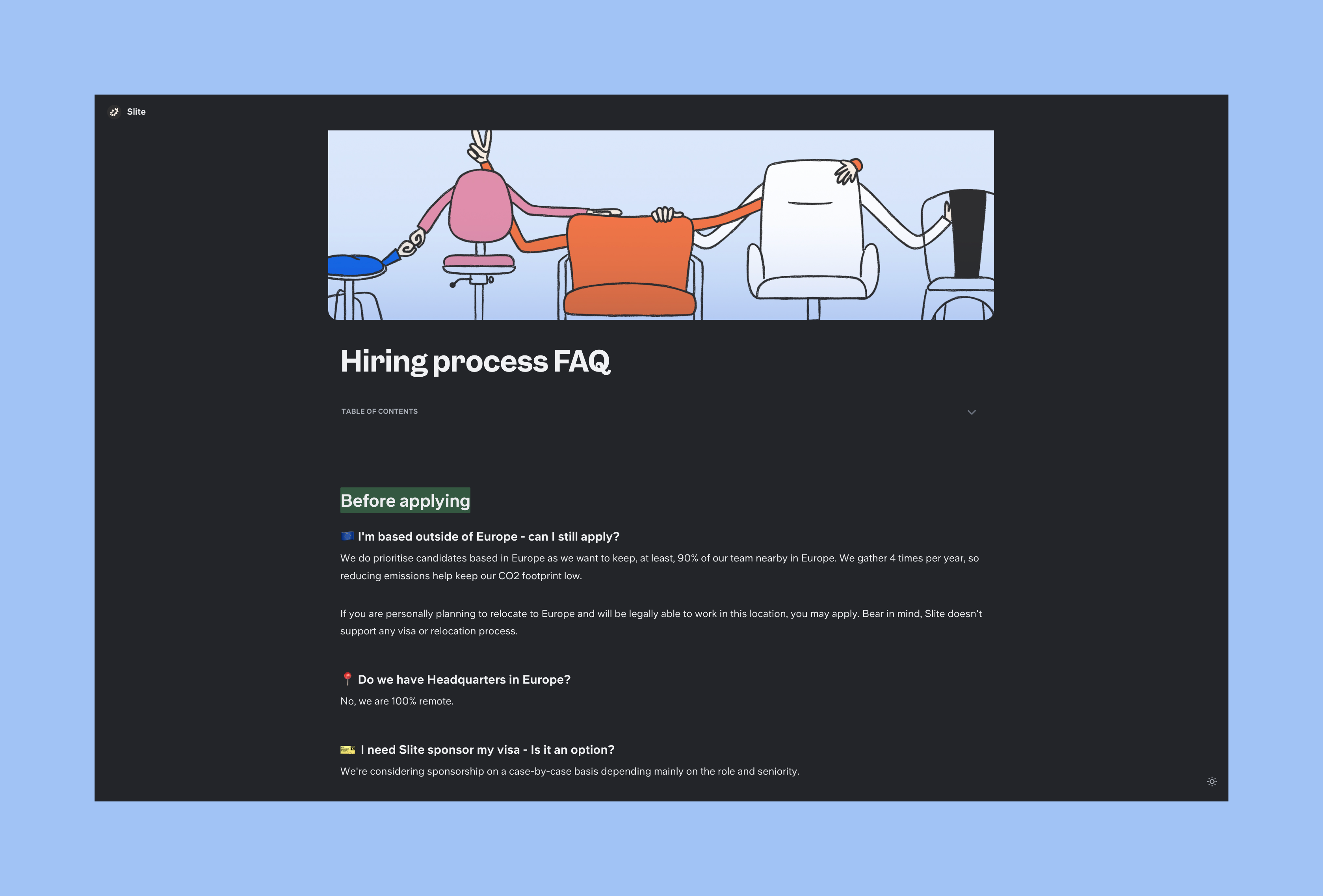The quickstart guide to nurturing a culture of documentation

No matter what country you’re in, what competition you’re following, or what type of championship is on the line, ask any sports coach what the key to success is and they’ll say: building a culture of excellence. This is such a consistent answer that there are academic papers dedicated to studying the similarities between high-performing athletic teams.
Workplaces also rely on culture to shape results, including around collecting and sharing knowledge. No matter how “All-Star Team” your employees are, if your workplace doesn’t build the process of ongoing, continual documentation into team expectations, it won’t get done. And whatever knowledge you create won’t be used by your team to reach greater heights.
Here’s how to approach building a culture of documentation for modern teams.
Start from before day one
The difference between good and bad documentation culture actually starts in the recruiting process, because your culture should shape how you interact with and evaluate candidates.

Just as you take time to assess culture fit in other areas, ask questions about how an interviewee shares their knowledge with colleagues, problem-solves, and records their thoughts. And explain your company’s expectations for knowledge flow –– especially for candidates who are coming from workplaces with poor documentation culture.
More, give a clear overview of the hiring process to candidates in the same way you communicate with your team: by making and sharing (multimedia) docs. This will help candidates get a feel for how you work and if they fit in with your approach.
Make documentation part of onboarding
Onboarding is a key process that integrates new hires with company ideals and expectations. So you should require that new team members become familiar both with navigating documentation and adding to it during this time.
Have new team members check off these items in your onboarding process:
- Finding a piece of information in the documentation
- Knowing how to flag or request clarification on documented information
- Starting a new page and adding different types of media
- Documenting one of their onboarding meetings with a manager in a 1:1 doc
Empower new team members to find answers and ask questions through the channels that will set them up for maximum success throughout their tenure. And establish early on that they have things to contribute to documentation.
Set aside company time to maintain knowledge regularly
People know what you prioritize, and what you really prioritize. A basketball coach might say everyone has to have good sportsmanship or be benched. But if the star player gets away with throwing tantrums, the message is clear: it doesn’t matter how you behave, as long as you’re good.
With documentation, if you tell people to do it, but never actually follow up, people won’t do it consistently. So lead by example:
- Set aside regular time for updating documentation and keep your own docs up-to-date
- Make sure meetings and decisions have been recorded by clearly designating note-taking contributions, rotating between team members
- Remember that maintaining knowledge isn’t all about adding. As Slite's Founder, Chris Pasquier, says: make sure you “archive, remove and cut down” on unneeded docs to keep a clear and productive space for everyone
To help with maintenance, Slite has a verification feature so you know when the documents can be trusted or when they are due a refresh. You can also filter these docs to see everything that is marked as expired or unverified, making cleanup easier.
Team members can also sort, tag and filter your documentation to see what they own, where their expertise may be needed and what is incomplete or out of date.
Make asking –– and answering –– questions a consistent practice, for everyone
If people don’t feel comfortable asking for information, you don’t have a good culture of documentation.
If people don’t feel responsible for answering questions, or don’t feel comfortable doing so, you don’t have a robust documentation culture.
Even if you eventually decide to hire a knowledge manager, the whole team still needs to be comfortable creating and sharing their knowledge. Because documentation isn’t about writing things down for the sake of it. It’s about how wisdom gets from one team member to another.
That means:
- Be supportive and encourage asking questions, even “stupid” ones
- If a question has already been answered in your knowledge base, point people toward those pages rather than answering separately. With Slite Ask, our AI-powered assistant, you can ask your knowledge base as if it was one more teammate, and it will retrieve instant answers based on knowledge already documented by your team.
- Capture knowledge in a variety of ways in addition to text –– graphs, gifs, video, sketches, etc. –– so people can use what works for them
- Use templates to help people quickly and easily get their thoughts down
- Establish formal mentorship and opportunities sharing, and facilitate informal ways for knowledge to bloom, like themed team lunches or “happy hour” Q and A sessions
Gamifying can spice things up
Even professional athletes at the top of their game don’t just practice individual skills all day. While success in sports and business relies on building blocks that are often unexciting and regular parts of work, every now and again competition and games make things more interesting.
Here are a few ideas to mix into your culture or knowledge:
- Organize a knowledge treasure hunt within your knowledge base. Hide clues or riddles in different documents, with a reward for the person who finds answers or completes tasks first
- Host a monthly challenge that focuses on specific areas of documentation –– a “Best How-To Guide” challenge or a “Most Visited Document” challenge, for example. Recognize and reward winners at the end of each challenge
- Encourage employees to share their experiences and wisdom through storytelling and narrative, with an award for creativity or candor.This builds connections between team members and adds a personal level of interest to your docs
Be aware of gender bias
When it comes to tasks like taking notes on meetings and doing maintenance work on internal materials, women spend an average of 200 more hours a year than men, according to Forbes.
This is an example of unconscious bias that can affect who takes responsibility for knowledge creation and capture. Ramifications can increase if some of your knowledge sharing –– Communities of Practice, writing team updates –– is informal and relies on volunteers, who are more likely to be women.
In a good culture of documentation, two things will combat this bias.
First, everyone should be responsible for creating, maintaining and using your documentation. This is especially so for management, founders and the c-suite, who set the tone. As Hanna Larsson, remote work and go-to-market advisor, says: “No one is too senior to document.”
Second, contributing to creating, saving and using team knowledge well should be taken into account when evaluating job performance overall. If these vital tasks are appropriately weighted, women will not be stuck with extra work and no reward, and men will not unknowingly leave work to their colleagues without repercussions.
Don’t let knowledge leave with employees
Team members will inevitably move on, either internally to new roles or for opportunities outside your company, and they’ll take their knowledge with them.
The best way to combat this is to have a strong culture of documentation throughout their tenure.

But you should also make it an expectation that employees who are leaving the company document critical insights and processes before they leave, just as they need to hand off work to teammates and do an exit interview.
Knowledge never ends
Knowledge and knowledge management are an essential part of every business. And, like most things that are central to running a company, you can’t just “do it once” and get it out of the way. Like an elite athlete trains hard every off-season, focuses on winning every game and never takes details like eating a snack or taking a nap for granted, your teams can’t take their foot off the gas and expect good documentation and knowledge sharing will simply happen.
Set yourself and your teams up to win by treating knowledge and documentation as a continuous process that you are lucky enough to work together on, every day.

Written by Lauren Christiansen
Lauren Christiansen is a freelance marketer with a passion for content that helps teams work better, together. While she specializes in B2B SaaS professionally, in her spare time you can find her unplugged and hiking in the woods of New England.


